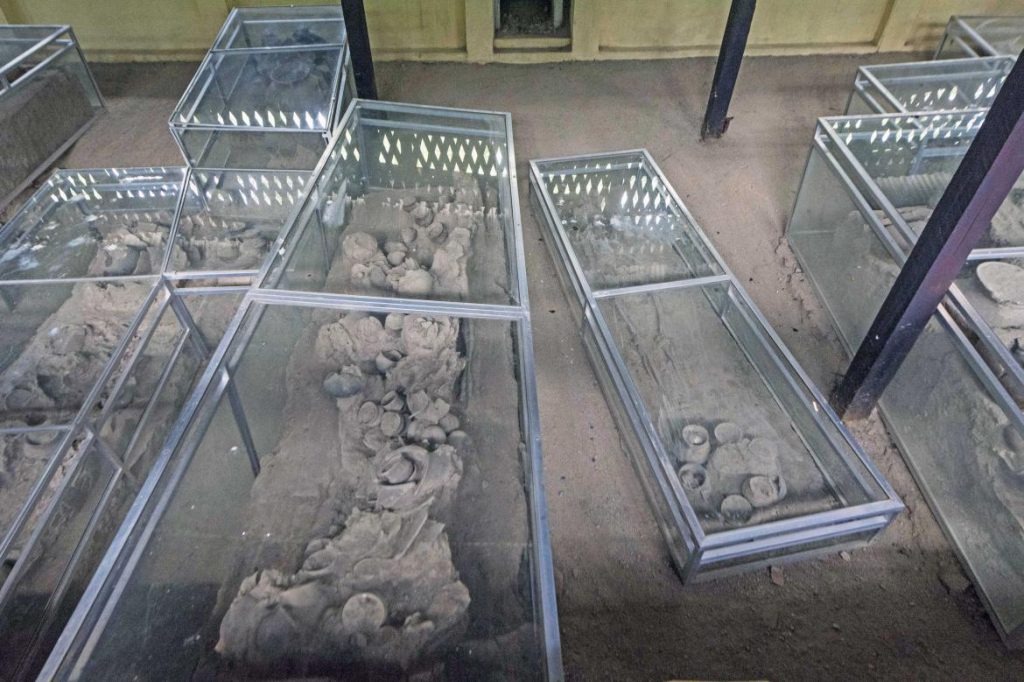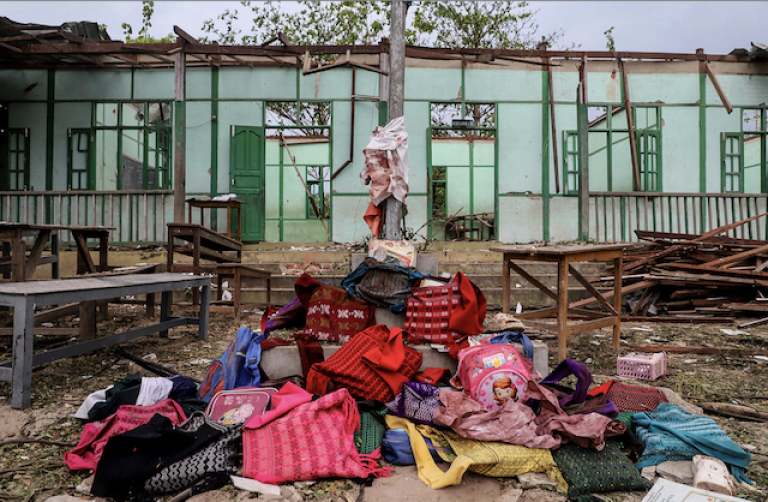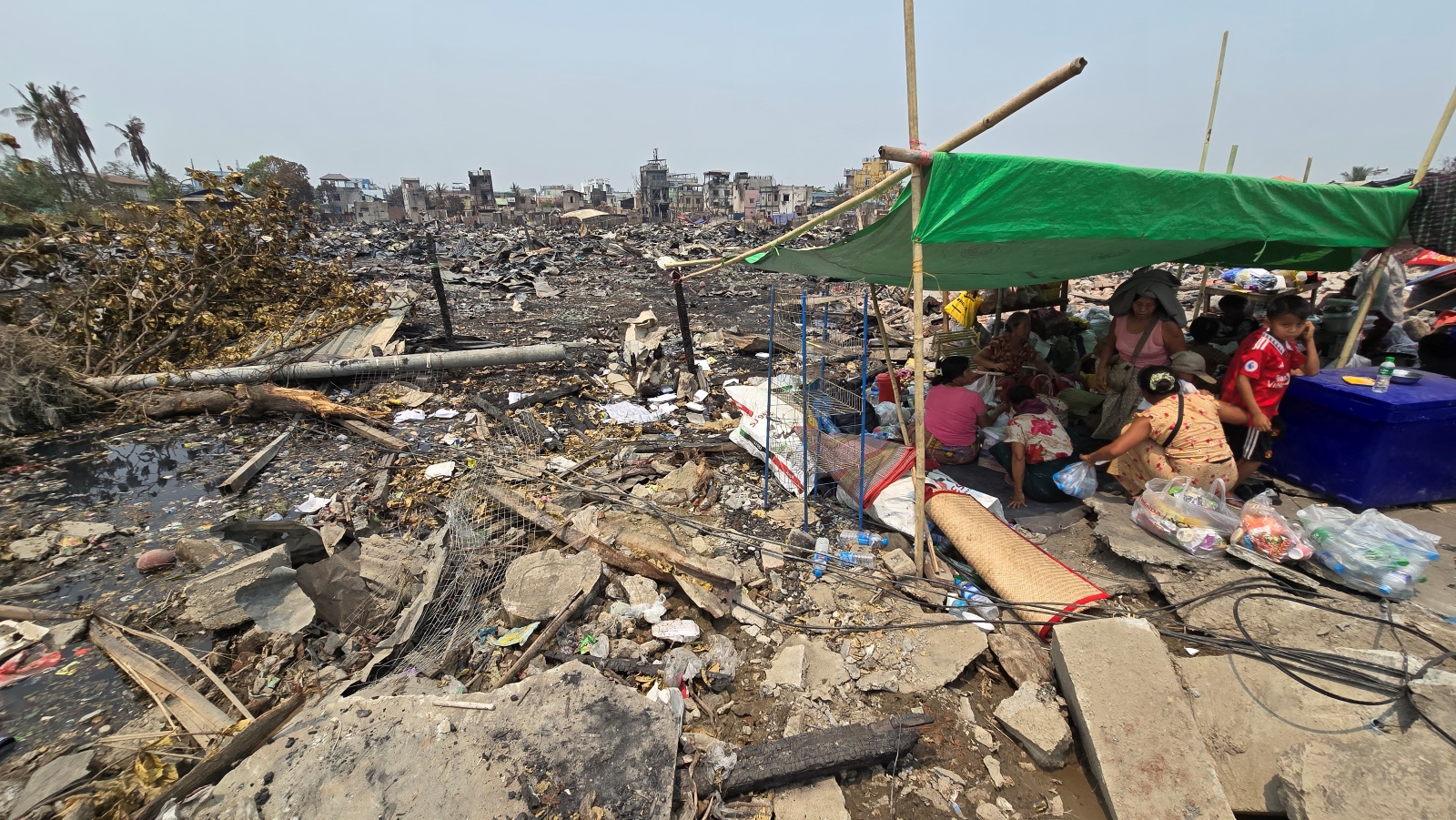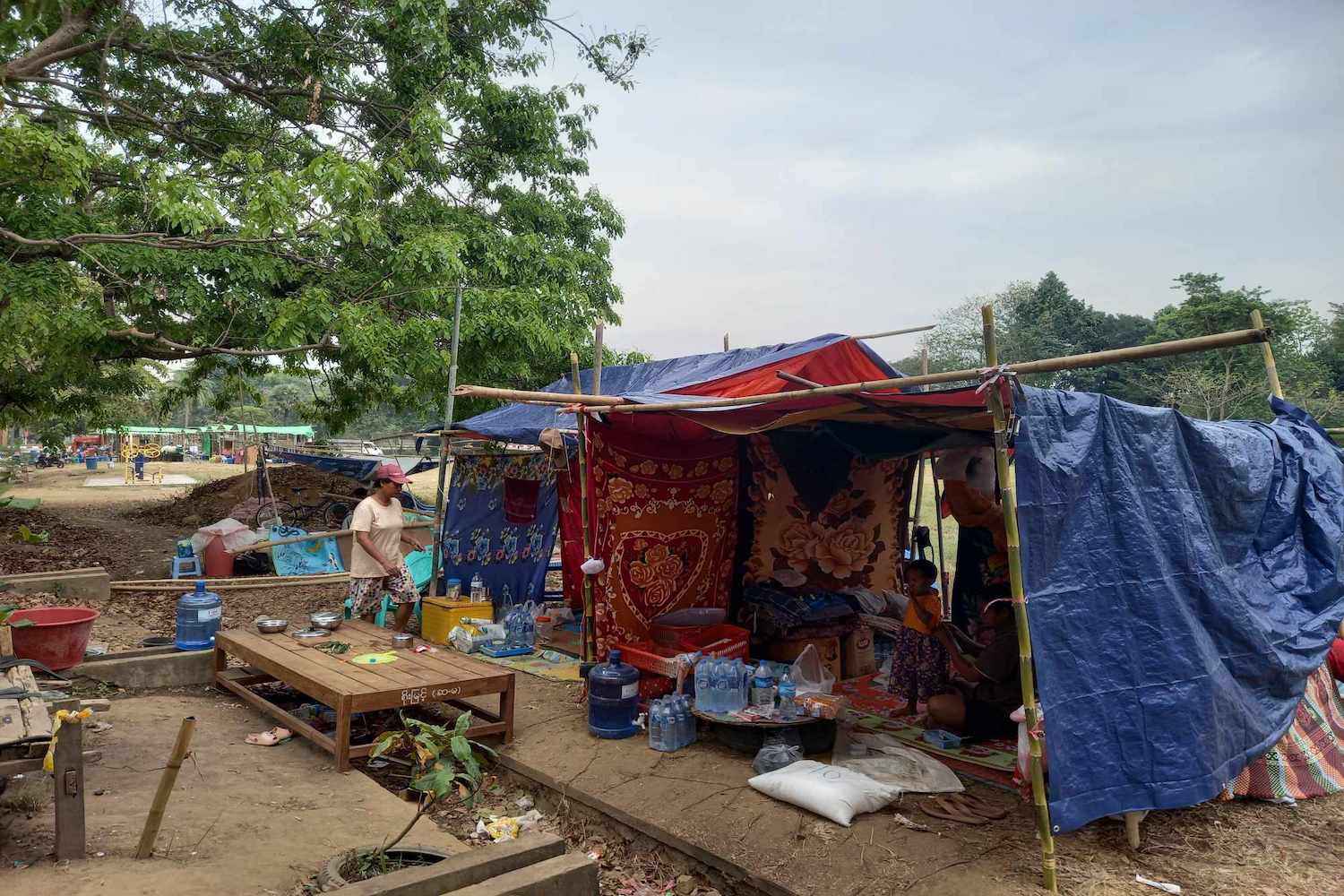Briefly showcased by the former military regime in the late 1990s, work has resumed at the Nyaung-gan archaeological site in Sagaing Region in recent years.
By MRATT KYAW THU | FRONTIER
IN 1997, a farmer from Budalin Township in Sagaing Region was clearing land to establish a banana plantation when he found some skeletons just below the soil.
Because the area is unsuitable for growing paddy, many of the farmers work casually in other jobs during the rainy season. Each monsoon this particular farmer travelled to Mandalay, where he would work with Tampawaddy U Win Maung, a noted historian and traditional architect.
When the farmer went to Mandalay a few months after his discovery, he related the find to Win Maung. Suspecting it might be archaeologically significant, Win Maung visited the site and found that the torrential monsoon rain had already revealed more skeletons.
By early 1998, a government dig was underway at the burial site, which would become known as Nyaung-gan. When bronze artifacts were discovered, Nyaung-gan was deemed to be of both archaeological and political importance. Military Intelligence, led by General Khin Nyunt, the third most powerful person in the junta, soon took charge of excavations.
Support more independent journalism like this. Sign up to be a Frontier member.

A sign at the entrance to Nyaung-gan village. (Teza Hlaing | Frontier)
The discovery of bronze weaponry would prompt the junta to declare later that year that Myanmar was “the land which experienced the entire process of human history such as the period prior to evolution of the human beings”. But for all the fanfare, work at Nyaung-gan would come to a halt within a few years, as the political forces that thrust it to prominence soon relegated it back into the shadows.
The first dig
The road from Budalin to Nyaung-gan stretches to the horizon, lined by rows of trees: the thorny htanaung (Acacia leucophloea), their yellowish branches reaching untidily to the sky, and the fast-growing neem (Azadirachta indica), with dense crowns like umbrellas.
With such a refreshing, green view, it’s hard to believe we are in the central dry zone, in Sagaing Region. Cattle graze by the roadside, enjoying the breeze. Not far away, a vast plain is dissected by the Chindwin River, one of the country’s three biggest waterways.
Nearby Monywa, the Sagaing regional capital, is a road and river trading hub noted for its fine stands of shady neem trees. It is an old city that has played an important role in the country’s history and there are many ancient sites in the area.
The Nyaung-gan Bronze Age cemetery in Budalin, about 60 minutes north of Monywa, is the oldest of these. A wealth of bronze tools, ceramics and stone artifacts have been found at the site, which has been dated to between 1,500 BCE and 500 BCE.
To most Myanmar, Budalin is famous for a prominent monk, Sayadaw U Bote, and as the hometown of well-known leftist writer, journalist and politician, Thein Pe Myint, who died in Yangon in 1978 aged 63.

A map of the Nyaung-gan village site. (Frontier)
There are political reasons why few except archaeologists and historians are aware of the township’s ancient treasures, even though 18 Bronze Age tools from Nyaung-gan – spears, points, axes and a halberd – are displayed in the National Museum in Yangon.
The cemetery, near the village of Oakaie, is reached by a narrow road that is impassable in the rainy season. Five dig sites contain many skeletons and pots, which have been left in situ and covered in small, steel-framed glass boxes that look like coffins. Buildings enclose each of the five sites to protect them from the elements.
U Aung Khine was involved in the preliminary excavations at Nyaung-gan in 1998 and has been the site’s guardian ever since. He said the buildings were constructed about five months ago.
For many years, the skeletons, pots, tools and other artifacts were scattered and unprotected, he said. It is not known what was taken from the site before it was better protected.
The first excavations were conducted from January 30 to March 8, 1998, by the Mandalay branch of the Department of Archaeology, under its then deputy director, U Pauk Pauk.
The digs uncovered more than 150 artifacts. As well as human skeletal remains, ceramics, and bronze implements, they included polished stone rings and beads, recovered in a cemetery site measuring 64 metres (about 210 feet) by 91.5m (about 300 feet), Pauk Pauk wrote in a report of the excavations. The findings include the artifacts in the National Museum.
Soon Military Intelligence became involved. An assistant to Khin Nyunt heard about the dig and visited the site, taking a range of artifacts to show the general. The Office of Strategic Studies, a Military Intelligence agency established by the Ministry of Defence in 1994, took charge of the excavations, in collaboration with the ministries of defence, culture and education.

Former Prime Minister U Khin Nyunt ordered the Office of Strategic Studies, a Military Intelligence agency, to oversee the initial excavation of the Nyaung-gan cemetery. (AFP)
The discoveries were announced by the junta with great fanfare but interest in the site virtually disappeared after Khin Nyunt’s dramatic arrest and the subsequent purge of Military Intelligence in 2004. Nyaung-gan residents told Frontier that nobody dared go near the cemetery site after the purge because of a heightened fear of the military.
‘Since time immemorial’
But why were the generals so interested in a Bronze Age cemetery?
It was not Military Intelligence’s first foray into archaeology. In January 1997, Khin Nyunt learned of some rare primate fossils from the Pondaung area of Sagaing Region that had been discovered two decades earlier and were thought to be up to 40 million years old. By the end of February, a team had been established to find more evidence; numerous fossils were uncovered during subsequent site visits and foreign archaeologists were invited to help interpret the finds.
The suggestion was made that the primate remains indicated that mankind originated in Myanmar, a claim that the military apparently thought would build the country’s prestige internationally. In Mental Culture in Burmese Crisis Politics, scholar Gustaaf Houtman noted that military propaganda claimed the fossils indicated the “existence of Myanmar culture since time immemorial”.

Shelters to enclose the skeletons at Nyaunggan were built earlier this year. (Teza Hlaing | Frontier)
The purpose of this was two-fold: to enhance national prestige and transform the status of the country during a time of international condemnation, and to build the legitimacy of the modern, military-run state – at a time when its legitimacy was being questioned both at home and abroad – by demonstrating that the geographical area encompassing modern Myanmar had been inhabited continuously since ancient times.
As Houtman noted, these goals, which he termed the “Myanmaification of Burma” because they gave primacy to the ethnic Burmese, were considered of “such importance that the more significant archaeological finds require nothing less than the Defence Services Intelligence Unit”.
Khin Nyunt was quite explicit about his reasons for taking up such a cause. At a seminar on June 1, 1998, Khin Nyunt told attendees that “a nation’s prestige could be measured in terms of its lineage and historical and cultural background”.
“A nation that can provide historical evidence of its ancient roots and the emergence and growth of its culture, traditions and national traits is a nation in which national fervor and patriotism thrives,” state media quoted him as saying.
“The Myanmar people are not visitors who came from a faraway land and settled here. Life began here in this Myanmar environment of land, air and water. Their roots are here.”
The excavations at Nyaung-gan played precisely the same political role. This was emphasised two days after Khin Nyunt’s June 1 speech, when a joint seminar was held between the Pondaung fossil team and the team excavating the cemetery at Nyaung-gan.
Prior to Nyaung-gan, there had been no confirmation of Bronze Age culture in Myanmar; the cemetery therefore represented the “missing link”.
In 1938, a Briton, Mr TO Morris, wrote in the Journal of the Burma Research Society that Copper and Bronze Age items were “extremely rare” in Burma, particularly in comparison to Stone Age artefacts.
In the article, “Copper and Bronze Antiquities from Burma”, he wrote that he had only been able to trace 14 copper or bronze antiquities “of Burma origin”, most of which were found in Shan State. However, he speculated that “when the story is known more fully the interactions of the late stone and early metal-working cultures in Burma will prove to have been very complex”.
Many researchers subsequently questioned the origin of the items in Morris’s article. During the socialist era, from 1962 to 1988, a few state-sponsored books even implied that there was no indigenous Copper Age or Bronze Age culture in Burma.
“Since those were surface finds, scholars were left with the question whether the bronze implements were not imported,” wrote Daw Ni Ni Myint, former director of the Universities Historical Research Centre, in her monograph, “Report on recent archaeological finds in Budalin Township, Sagaing Division”, published in the Myanmar Historical Research Journal, Number (3), December 1998.

The Nyaung-gan display at the National Museum in Yangon. (Teza Hlaing | Frontier)
Dr Than Htike, director of the Department of Archaeology, National Museum and Library, Nay Pyi Taw, said that the suggestion there was no Copper or Bronze Age cultures prompted many archaeologists and historians to search for evidence to the contrary.
“Many Burmese scholars went to India [during the socialist era] to boost their study of history and archaeology, and when they came back they started researching those archaeological sites,” he said.
Than Htike said lack of resources was an issue. Some carbon dating of artifacts was conducted in the late 1960s, but was limited because of the cost.
“It cost $800 for one test and as there were some problems in the country then, scholars could not afford to pay and research efforts almost stopped,” he told Frontier.
Return to Nyaung-gan
After years of neglect, excavations resumed near Nyaung-gan in January 2014 in collaboration with the Mission Archéologique Française au Myanmar, the French archaeological mission in Myanmar. The impetus appears to have been the discovery of more skeletal remains by a local farmer.
That year, the team excavated ancient cemetery and habitation sites near the village of Oakaie, about 2km south of Nyaung-gan. Twenty-one graves were excavated, followed by 24 in 2015. In 2016, three new trenches were opened at Nyaung-gan, yielding seven burials. One of the skulls showed evidence of trepanation, a surgical procedure in which a hole is drilled to relieve pressure on the brain.
The Oakaie cemetery was “notably poorer in grave goods” than Nyaung-gan, with pottery the most common artifact recovered, researchers wrote in a 2015 article, “Dating the Myanmar Bronze Age: Preliminary 14C dates from the Oakaie 1 cemetery near Nyaung’gan”, published in the Journal of Indo-Pacific Archaeology.
What the dig did yield – in contrast to the Nyaung-gan excavation – was five femurs that could be tested to ascertain their approximate age. Four of the samples returned a range of ninth to sixth centuries BCE, while the other was dated to the fourth or third centuries. This is considered an outlier because the pottery grave goods also suggest an early first millennium BCE date for the Bronze Age in Myanmar.
Ms Anna Willis, a member of the excavation team from Australia’s James Cook University, later wrote that the digs had “provided a lot of information which will be used to … help understand the social, cultural, economic and political development of the people in the area and help contextualise these within the wider Southeast Asian region”.

Work resumed at Nyaung-gan in 2014 in collaboration with the Mission Archeologique Francaise au Myanmar, the French archaeological mission in Myanmar. (Teza Hlaing | Frontier)
The Department of Archaeology, National Museum and Library in Nay Pyi Taw said the collaboration would run for five years. The French team will return to the site in February.
In a presentation at the French Institute in February last year, MFAM director Dr Thomas Olivier Pryce spoke of the importance of the Nyaung-gan to prehistory studies in Myanmar and the region.
“Bronze Age settlements in Southeast Asia are very rare. There are maybe four in Thailand and a couple in southern Vietnam. It seems that the settlement sites in Oakaie village are very big,” Pryce was quoted as saying by the Myanmar Times.
Pryce said the discoveries at Nyaung-gan should be a source of pride for the people of Myanmar because they allow for the recovery of valuable information about the ways of life of ancestors.
Than Htike is hopeful that further excavations and research will reveal significant findings, including that Nyaung-gan is one of the biggest and oldest Bronze Age sites in the world.
Daw Khin Cho Cho Han, deputy manager of the National Museum in Yangon, said Nyaung-gan’s importance meant it deserved more attention in the museum.
“I want the National Museum to upgrade and expand the displays from Nyaung-gan and other Bronze Age sites,” she said.
TOP PHOTO: Skeletons uncovered in the late 1990s lie in situ at the Nyaunggan Bronze Age cemetery in Budalin Township, Sagaing Region. (Teza Hlaing | Frontier)







